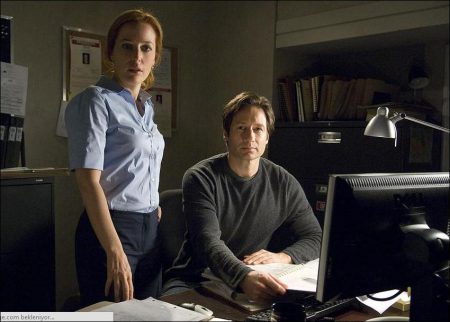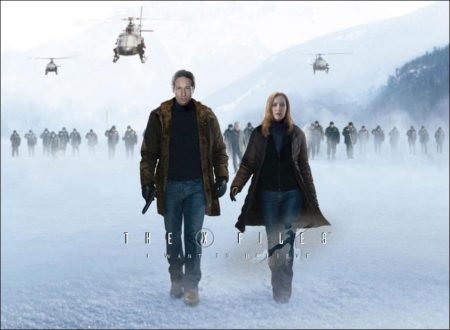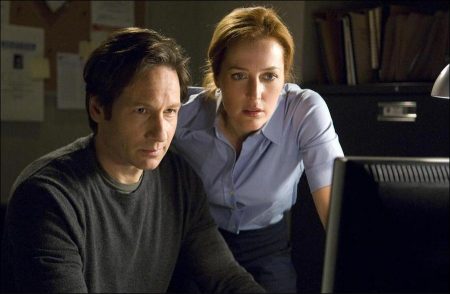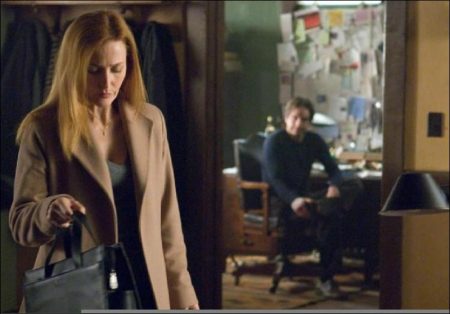Tagline: To understand the truth, you have to believe.
The X-Files: I Want to Believe movie storyline. Fox Mulder and Dana Scully both worked at the FBI as partners, a bond between them that led to their becoming lovers. But now they’re out of the FBI and have begun new careers. Scully works as a staff physician at a Catholic hospital. Her focus these days is on a young boy with an incurable brain disease. Administration wants to give up on him. Scully, who feels a special bond with the boy, does not.
Meanwhile, Mulder’s focus is on clipping newspaper articles, throwing pencils into his ceiling and writing about the paranormal. Scully and Mulder are brought together as partners again when a special case requires Mulder’s expertise and Scully is prevailed upon to convince him to help. The case involves a pedophile priest who claims he is having psychic visions regarding the whereabouts of a missing FBI agent.
The X-Files: I Want to Believe is a 2008 American supernatural thriller film directed by Chris Carter and written by both Carter and Frank Spotnitz. It is the second feature film installment of The X-Files franchise created by Carter, following the 1998 film. Three main actors from the television series, David Duchovny, Gillian Anderson, and Mitch Pileggi, reappear in the film to reprise their respective roles as Fox Mulder, Dana Scully, and Walter Skinner.
About the Production
Unlike the first film, the plot does not focus on the series’ ongoing extraterrestrial based mytharc themes, but instead works as a standalone thriller horror story, similar to many of the monster-of-the-week episodes that were frequently seen in the TV series. The story follows Mulder and Scully who have been out of the FBI for several years, with Mulder living in isolation as a fugitive from the organization and Scully having become a doctor at a Catholic-run hospital, where she has formed a friendly relationship with a seriously ill patient. When an FBI agent is mysteriously kidnapped, and a former priest who has been convicted of being a child molester claims to be experiencing psychic visions of the endangered agent, Mulder and Scully reluctantly accept the FBI’s request for their particular paranormal expertise on the case.
Created and executive produced by Chris Carter, “The X-Files,” which premiered on FOX on September 10, 1993, chronicled the lives and adventures of Fox Mulder and Dana Scully, two disparate FBI agents assigned to investigate unsolved cases within the Bureau – cases that often involved the paranormal, the supernatural, and the inexplicable.
“The X-Files” won numerous awards and honors, including a George Foster Peabody Award for Excellence in Broadcasting, three Golden Globes for Best Dramatic Series, a Golden Satellite Award for Best Drama Series, Science Fiction and Fantasy Saturn Awards for Outstanding Television Series, and a Parents’ Choice Honor for Best Series. In 1997, Gillian Anderson won an Emmy for Outstanding Lead Actress in a Drama Series.
“The X-Files” was as much of a phenomenon abroad as it was in the United States. The show’s conspiratorial tone and blend of paranoia, horror and suspense made it the most popular TV series in Canada, and the highest-rated series on Britain’s BBC2.
The show’s nine-season run came to an end in 2002. In 1998, Twentieth Century Fox released the first feature film based on the series. The film – produced and written by Carter and co-written by Spotnitz – became a worldwide success, taking in $187 million in theatrical box office.
Production Information
Months after shooting had wrapped, Carter remained as circumspect about the story as he was during its development and production. “Mulder and Scully are drawn back into the world of the X-Files by a case,” is all he’ll add about the plot. Perhaps more clues…to something….can be found in the film’s title. “I Want to Believe” is a familiar phrase for fans of the series; it was the slogan on a poster that Mulder had hanging in his office at the FBI. “It’s a natural title,” says Chris Carter. “It’s a story that involves the difficulties in mediating faith and science. It really does suggest Mulder’s struggle with his faith.”
Carter is much more revealing about his goals for the film. “Simply put, we want to scare the pants off of everyone in the audience,” he says. While the scale and scope inherent in the medium of film allowed the filmmakers to take the story and characters where the show couldn’t go, Carter says “”The X-Files: I Want to Believe”” also marks a return to the series’ roots, when it was the lone beacon on television for fans of thrillers, supernatural tales, and of horror stories. “The film encompasses all the best things people loved about the show. It’s scary, creepy, and has a good mystery. With The X-Files, we often scared people by what they didn’t show, and we use that device for the movie.”
Adds writer-producer Frank Spotnitz: “I think the best part of The X-Files was that it could make you afraid of anything. They didn’t tell typical horror stories or adhere to popular genre conventions. And this movie is in that tradition of showing things that you would not see in most scary movies.”
Unlike the first The X-Files motion picture, released in 1998, Carter and Spotnitz’s story for “”The X-Files: I Want to Believe”” does not require audiences to understand the series’ complex mythology that stretched across its nine seasons on the air. “The first movie was kind of an epic episode of the show, but “”The X-Files: I Want to Believe”” is a real, stand-alone movie,” explains Carter. “If the show hadn’t existed, this is a story that still would have found its way to the big screen.”
After ten long years since the first film – and six years since the close of the series – Carter and Spotnitz felt the time was right for a new The X-Files movie, not only to provide the show’s legions of fans with a new case for Mulder and Scully, but to introduce a new generation to these characters already beloved by millions. “It has struck me over the last several years, talking to college-age kids, that many of them really don’t know the show,” says Carter. “A twenty-year-old today would have been too young when the show debuted [16 years ago]. So there’s a whole new audience for The X-Files. And this film was made to satisfy them.”
“Writing and making this film was far more than an exercise in nostalgia,” adds Frank Spotnitz. “Chris and I took a long, careful and emotional look at Mulder and Scully and where they would be at this point in their lives. We would talk for hours and hours about the story and what it meant to us.”
The two filmmakers decided that the story, and the critical Mulder-Scully dynamic, would take place in what they call “real time” – it’s been six years since we last saw them in the series finale, and the film would reflect that progression. “They’re six years older and six years wiser, and their relationship has evolved quite a bit,” says Carter. “Mulder and Scully have gone through a lot [in that period], so there is much in the movie about the state of their relationship – and its future.”
David Duchovny says that presenting Mulder and Scully as they are today, was a critical decision. “It was important to allow time to go on in the world of The X-Files as it’s gone on in the world at large. I think one of the most interesting things we do as actors is to try and embody the same character as time goes by, working with the changes of life or consciousness that happen to us with time.”
The Mulder-Scully relationship continues to be defined by a unique chemistry – a spark that defies the conventions of screen romances. “The chemistry with David is completely easy,” says Anderson. “It’s something we seem to be able to slip into with our eyes closed. From the second we started working together on this film, it was there.”
On the set of “”The X-Files: I Want to Believe””, the electricity between the actors and between their respective characters was impressive even to those who had witnessed it up close for so many years. “The first day of shooting, when I saw David and Gillian working together, I got chills,” says Chris Carter. “David and Gillian have always had that chemistry. Seeing them working together was like having the family back together.”
Beloved by the large subset of fans who call themselves “Shippers” (taking their name from the fourth syllable of the world “relationship”), the Mulder-Scully love story remains a very different kind of screen romance. “It’s always been a chaste kind of relationship,” says Duchovny. “It’s an old-fashioned romance where all the physical intimacy is achieved through looks, or by holding hands, or by kisses on the forehead. “Mulder and Scully are meant for each other,” the actor continues. “But there’s always an obstacle that threatens their relationship. This movie is very much about that obstacle.”
Chris Carter further explores the characters’ bond: “For me, The X-Files has always been a romance – an intellectual romance of the mind that’s very rare and restrained. It is intimate but not physical. That is a big part of the chemistry. And from the beginning of the show, it was David and Gillian who created our success. Without them, the show would not have worked.”
Actor chemistry notwithstanding, it was somewhat easier for Carter and Spotnitz to return to the world of The X-Files than it was for stars David Duchovny and Gillian Anderson. Carter, who guided the show for over 17 years as its creator and executive producer, says simply that coming back to these characters and their universe felt “like the most natural thing in the world.”
Spotnitz elaborates: “When Chris and I sat down to write the film and revisit Mulder and Scully, I was surprised to find that they came right back to me. We had a lot of thoughts about what they’d been doing and where they were in their lives. And it was really nice coming back, because I had missed Mulder and Scully. I had missed hearing their voices.”
However much the filmmakers – and of course, the fans – missed the characters, various issues delayed the start of a new The X-Files movie until late last year. Carter credits David Duchovny as being a key advocate of a new film. “I’d say David was as responsible as anyone for getting this movie made. He campaigned for it. He wanted to do it. David was really the key cheerleader in sustaining our interest in doing another film.”
Indeed, Duchovny had wanted to return to Fox Mulder and The X-Files since the show ended its long run in 2002. “I always felt that The X-Files as a movie franchise had real life in it,” he points out. And having played Mulder for nine years, Duchovny thought he could slip back easily into the character. But when cameras started rolling last winter, Duchovny discovered that finding Mulder was more elusive than he had expected. “I thought I would fall back into Mulder very naturally, but at first playing the character felt a little odd. I didn’t want to make any drastic changes in the way I played Mulder because the character is so well-known. But of course I’m older now – and so is Mulder – so some things had to change.”
Similarly, Gillian Anderson found returning to Dana Scully came not without significant effort. “On the first day of shooting,” she remembers, “I was pretty confident about returning to the role. I am usually terrified when I start a project, but that wasn’t the case with this one.” But the challenges of slipping back into a character Anderson thought she had left behind years before quickly became apparent. “I had a really difficult first couple of days [of shooting the film]. I was having a really hard time finding Scully’s voice, and I think part of that is because since the show ended, I’ve been doing everything in my power to take on roles that were very different from Scully. The work I’ve been doing [since the show ended] has involved creating new characters from scratch.
While the Mulder-Scully dynamic was the nexus of much of The X-Files’ run, the franchise has long been recognized for bringing in top-flight actors who have made invaluable contributions to its legacy. “”The X-Files: I Want to Believe”” is no exception to this tradition. Amanda Peet, who recently starred in the series “Studio 60 on the Sunset Strip,” joins The X-Files universe as ASAC Dakota Whitney. Like everything else connected to the film, details about Whitney have been shrouded in secrecy. “Whitney enlists Mulder’s help with a case,” Peet does reveal. “She is an FBI agent who may – or may not – begin to feel a connection with Mulder.”
Peet says joining The X-Files team had, not surprisingly, its unusual moments. “It felt a bit odd to be a guest in this phenomenon. But it was enjoyable, too, becoming a part of this world that is so well-established. And to watch David and Gillian portray this iconic couple [Mulder and Scully] was extraordinary.
The shoot’s physical rigors were perhaps her greatest challenge. “I should have suspected…something…when, before production began, Chris Carter asked me if I was fit – could I run in the snow? Now, I had given birth eight months earlier, and I hadn’t exactly been running any marathons. But of course I told Chris, `Yeah, I’m in shape! And the first four days of filming had me running, running and running – and hoping I would look cool.” (Adds Duchovny: “It’s impossible to look cool running in snow.”)
Joining Peet’s Dakota Whitney as an FBI agent new to The X-Files is famed rapper (and host of MTV’s “Pimp My Ride”)Alvin “Xzibit” Joiner, who portrays Agent Mosley Drummy. In a strange, very X-Files-like coincidence, Carter had listened to a song performed by Xzibit that referenced The X-Files. “It was weird that Chris had heard that song,” admits the rapper/actor. “But he’s that kind of guy, you know; he’s into what he’s into.” (Carter’s intellectual and cultural pursuits extend beyond rap music – he recently had a fellowship studying string theory.)
Xzibit, a longtime fan of the series, says that “being part of the lineage of this great phenomenon is incredible.” As part of this lineage, Xzibit is well-aware that most details about Agent Drummy must remain classified until the film’s release. He’ll admit that Drummy is a “by-the-book kind of agent who is very intense. He doesn’t take no for an answer, and he has no time for Mulder’s strange ideas. Because if Agent Drummy can’t see it, feel it, touch it, or kill it, then he doesn’t believe it.”
A very different kind of character is essayed by noted actor Billy Connolly, whose Father Joseph Crissman is a dark, complex character with a haunted past. “It will be a character to which audiences will react strongly, which is one reason I was drawn to it,” says Connolly. “When Chris Carter told me about Father Joe, I knew I must do the part – and thus horrify my family and friends.
“But the scariest thing for me was learning that Chris had me in mind when he wrote the character!” (Carter is a longtime admirer of Connolly’s work, especially of his performance in the film Her Majesty, Mrs. Brown.)
Filming an X-Files story can be an inherently strange experience – and fodder for Connolly’s brand of off-kilter humor. “When you’re doing an X-Files movie, you’re not going to be singing `Kum Ba Yah’ around a campfire,” he notes. “You know that it’s just going to be a weird experience.” Case in point: “While filming in [the snowy Canadian ski resort] Whistler, we were creeping around for days, looking for weird stuff in the middle of the night.” Weird stuff, indeed – much of it in the form of a threat the likes of which, Connolly promises, “you’ve never before experienced in a film.”
Obviously, it’s nearly impossible to discuss “”The X-Files: I Want to Believe”” without mentioning the secrecy surrounding its story, production and several of its characters. And the filmmakers wouldn’t have it any other way. “To me,” says Carter, “this movie is like a Christmas present. I want it opened on Christmas morning and not before. I don’t want people shaking the box or sneaking a peek under the wrapping. “I believe that audiences will appreciate and enjoy the moviegoing experience more, if they don’t know the story in advance. So we did everything we could to preserve the surprise.”
To that end, only the director and producers had a copy of the full script. The actors were invited to read the script, only to see it whisked away as soon as they had finished. Select department heads read the script in an enclosed room under video surveillance, after which the script was returned to a locked vault. All who read it were asked to sign a confidentiality agreement. More than ninety percent of the shooting crew had little information about the story – an obstacle that failed to prevent them from preparing for the day’s work.
In fact, everyone rose to this new professional challenge. “It truly was entertainment,” states production designer Mark Freeborn. “I’ve never done a film before without having a script close at hand. If you were one of the anointed, you had one with your name watermarked on it. But even then, I could only refer to it in a secure room with three video monitors trained on me.
“There was a running joke amongst a few of us, when we had a question about something, which went along the lines of, `Well, let me check my script. Oh, wait a minute, I don’t have one!’”
Cast members received sides (the day’s script pages reduced in size) on the days they were shooting, each individually watermarked with the actor’s name. At the end of each shooting day, the sides were collected and then shredded. Actors and their character names were given aliases on call sheets and shooting schedules. Dubious information and questionable images were leaked to the internet, making it difficult for even the most astute fan to discern fact from fiction.
Coming Home
During pre-production, the filmmakers made the decision to shoot The X-Files: I Want to Believe where it all began – Vancouver, British Columbia, Canada, which served as the series’ home base for its first five years. “Vancouver is where we first succeeded,” states Carter. “I think that if there are ten things to credit with the success of The X-Files, then Vancouver ranks near the top of that list.”
“From the beginning,” confirms Spotnitz, “we liked the idea of coming back home to Vancouver. It was a heartbreaker for us, leaving Vancouver after season five. There were a lot of tears shed. And so, revisiting The X-Files gave us a chance to also revisit familiar faces and friends that we had left behind. As Chris and I wrote the movie, we imagined we’d be shooting it in Vancouver and taking advantage of the locations that are in and around the city. The locations were everything we hoped they would be.”
Carter, Spotnitz, Duchovny and Anderson were thrilled to reconnect with many of the original crew from The X-Files (as well as with crews from other Vancouver-based shows from Carter’s Ten Thirteen productions, including Millennium, The Lone Gunmen and Harsh Realm). Those on hand for this “reunion” included Tom Braidwood (first assistant director-second unit – who also played “Lone Gunman” Frohike on The X-Files and on the spin-off “Lone Gunmen” series), John S. Bartley, ASC, CSC (second unit director of photography), Dave Gauthier (special effects coordinator), William Terezakis (special makeup effects designer), Mat Beck (senior visual effects supervisor), Michael Williamson, CAS (sound mixer), Shirley Inget (set decorator) and Portia Belmont (script supervisor).
Principal photography began last December in Vancouver. Cameras rolled for three months throughout the city and some of its surrounding municipalities. Cast and crew also traveled about 100 miles north, past the famed Whistler Ski Resort (home of the 2010 Winter Olympics) to shoot for three weeks in and around the snow-shrouded community of Pemberton, where temperatures often dropped below 0 degrees Celsius. (One evening, Gillian Anderson was so cold she had trouble moving her lips to deliver her lines.)
In Pemberton, Carter and his team staged some of the movie’s most dramatic exterior scenes and stunt sequences. Here, too, secrecy was the order of the day…and of the night. “One of the hardest nights of shooting, we were filming in a place that was not exactly in the script and that was not exactly scripted,” says Carter. “I swear to you, no one – including David [Duchovny] – knew what I was doing. I was just leading people. `We’re going to shoot here and we’re going to do this,’ was all I’d say.”
Returning to Vancouver was only one of several ways The X-Files had come full circle. “I think the reason The X-Files series was so successful was that Chris imagined a beautiful universe, perfectly devised,” says Spotnitz. “He created two very powerful characters, perfectly cast, with opposing views of the world – one a believer, the other a skeptic. Mulder and Scully dealt with the limits of what we understand about life and about the universe. It really is an incredibly rich and diverse universe – and an endless source of storytelling I think the voice of this movie is still very clearly the voice that Chris defined in the series’ pilot, sixteen years ago.”
Clearly, a new film based on The X-Files was a long time coming. But Carter thinks the delay worked to the project’s advantage – that the interval between films enhanced the long-standing interest in a new chapter in the franchise. “It certainly helped renew my appetite,” he points out.
And there’s little question that it has peaked the excitement, anticipation and fervor of the legions of “X-Philes” who have long wanted to believe in a new case for Mulder and Scully.
About The X-Files
Created and executive produced by Chris Carter, The X-Files, which premiered on FOX on September 10, 1993, chronicled the lives and adventures of Fox Mulder and Dana Scully, two disparate FBI agents assigned to investigate unsolved cases within the Bureau – cases that often involved the paranormal, the supernatural, and the inexplicable.
The X-Files won numerous awards and honors, including a George Foster Peabody Award for Excellence in Broadcasting, three Golden Globes® for Best Dramatic Series, a Golden Satellite Award for Best Drama Series, Science Fiction and Fantasy Saturn Awards for Outstanding Television Series, and a Parents’ Choice Honor for Best Series. In 1997, Gillian Anderson won an Emmy for Outstanding Lead Actress in a Drama Series.
he X-Files was as much of a phenomenon abroad as it was in the United States. The show’s conspiratorial tone and blend of paranoia, horror and suspense made it the most popular television series in Canada, the highest-rated series on Britain’s BBC2, and one of the biggest sensations ever in Japanese television.
The show’s nine-season run came to an end in 2002. In 1998, Twentieth Century Fox released the first feature film based on the series. The film – produced and written by Carter and co-written by Spotnitz – became a worldwide success, taking in $187 million in theatrical box office.
The X-Files: I Want to Believe (2008)
Starring: David Duchovny, Gillian Anderson, Amanda Peet, Billy Connolly, Xzibit, Nicki Aycox, Callum Keith Rennie, Adam Godley, Alex Diakun, Carrie Ruscheinsky, Veronika Hadrava
Directed by: Chris Carter
Screenplay by: Chris Carter, Frank Spotnitz
Production Design by: Mark S. Freeborn
Cinematography by: Bill Roe
Film Editing by: Richard A. Harris
Costume Design by: Lisa Tomczeszyn
Set Decoration by: Shirley Inget
Art Direction by: Tony Wohlgemuth
Music by: Mark Snow
MPAA Rating: PG-13 for violent and disturbing content and thematic material.
Distributed by: 20th Century Fox
Release Date: July 25, 2008
Views: 88







